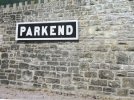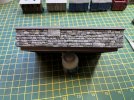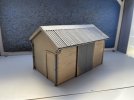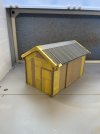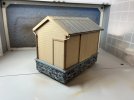Spike
Western Thunderer
New Year and first project completed - aim was to finish the first of two Forest of Dean goods sheds, going to take a break before continuing with the second Goods Shed.
Progress has been to produce a capping strip for the corrugated roof, Mother's Turkey Foil came in very handy, its ok but I think there must be a better solution. The first set of doors warped, they were removed and replaced with a new set which I am pleased with as these were some of the first items I have had 3D printed - decided to use the doors as a learning experience in how to draw in 3D.
I am really pleased with is the guttering. After I had posted the update in July I was looking for how to make the guttering and this just happened by chance to co inside with the launch of ModelU's guttering products. One phone call later as they had not even made it on to the website at that point and on my way to me were the parts I needed.
The parts from ModelU are just what was required and after some modification as there was only a T junction and I needed a down pipe right at the end of the guttering. Modifying the parts was easy to do the mouldings are good and with a bit of cleaning up look the part.



The owner of the building wants to paint it themselves so for now the building will be put away awaiting restrictions to be lifted to allow delivery.
Regards
Peter
Progress has been to produce a capping strip for the corrugated roof, Mother's Turkey Foil came in very handy, its ok but I think there must be a better solution. The first set of doors warped, they were removed and replaced with a new set which I am pleased with as these were some of the first items I have had 3D printed - decided to use the doors as a learning experience in how to draw in 3D.
I am really pleased with is the guttering. After I had posted the update in July I was looking for how to make the guttering and this just happened by chance to co inside with the launch of ModelU's guttering products. One phone call later as they had not even made it on to the website at that point and on my way to me were the parts I needed.
The parts from ModelU are just what was required and after some modification as there was only a T junction and I needed a down pipe right at the end of the guttering. Modifying the parts was easy to do the mouldings are good and with a bit of cleaning up look the part.



The owner of the building wants to paint it themselves so for now the building will be put away awaiting restrictions to be lifted to allow delivery.
Regards
Peter






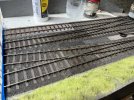



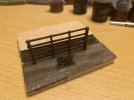


 .
.

